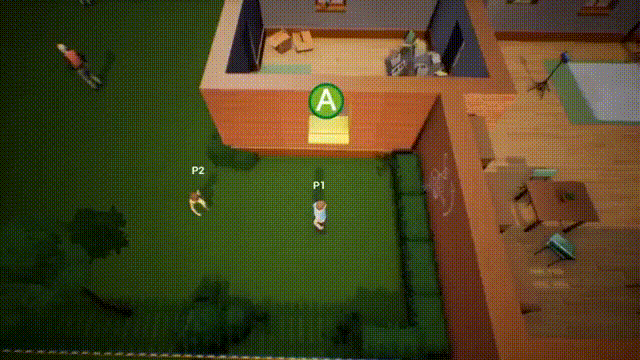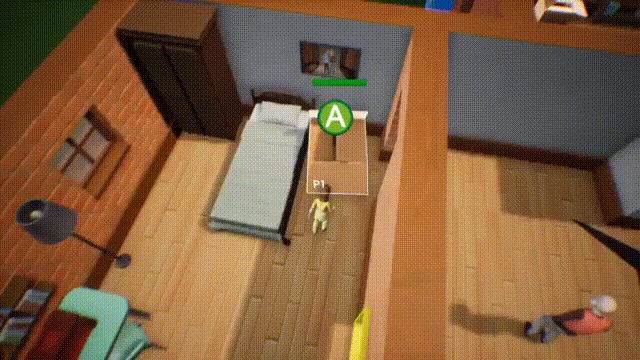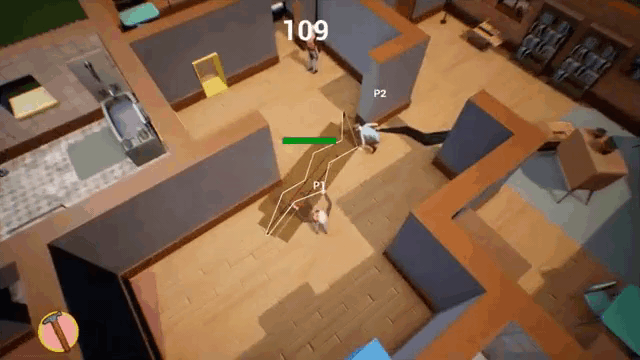
PICTURE PERFECT FAMILY
"In this third-person co-op game, two players incarnate different members of a family and must help each other out by using the different ability of each age group in order to defeat obstacles in the house and manage to bring everyone on the carpet in time for the family picture.
Communicate and work together to progress throughout the game and overcome the chaos growing with each level!"

Genre: Third-Person, Co-op, Puzzle
Engine: Unreal Engine 4
Platform: PC
Team: 8 People
Specification: Game for the 10th edition of the Ubisoft Game Lab Competition
Roles & Responsibilities:
-Game Design
-Level Design
-UX
-UI
My work as a Game Designer:
producing ideas and finding the Fun Factor
-
Brainstorming
The given theme for the contest was: Generation.
As the Game Designer of the team, I took notes of the ideas of everyone in the team and worked them into concrete game ideas with mechanics.
-
Planning ahead
I asked that we vote for a Top 3 ideas. We kept the #1 with the most Fun Factor (but also the most complexe of the three) and kept the other two as Plan B in case we found out after two weeks that our first idea was too audacious for the setting of the contest.
-
Synthesizing into Core Game Mechanics
After elaborating the game mechanics for the project, I cut them down into core game mechanics (a system of door-key puzzle), keeping the other ideas into a wish-list we could include depending of production speed.

-
Window requires Adult and Child
Using size and strength of
characters to proceed.
-
Locked Door requires a Key
Anyone can use a Key.
-
Debris requires Anyone
Clearing it up goes faster with two players working together.

-
Boxes may contain Items
Anyone can search through them.
-
Water puddle requires Towel
Adult and Child can clean up to
clear the way.

-
Fissures requires Wooden Plank and Tool Box
Elder can pick up and use Tool Boxes and Adult can pick up and hold down Wooden Planks.
-
Timer
Only Elder can see the remaining time before the picture.



-
Designing the 3C
After researching what type of controls and camera would best fit with the game mechanics, the game 60 Seconds! came out as best suited and was chosen as reference for the programmers.

-
Documenting
I put down all of the information concerning the gameplay, mechanics and camera into a document for the Game Design Document.
-
Working with Programmers
I worked closely with the programmers to make sure the mechanics were understood and suggested ideas as to how to make them using my knowledge of blueprints in UE4.
The Team Management tasks:
-
Taking Notes
I took notes during the weekly meetings and put them into a document online with a summary to keep track of pertinent feedback, what is next to do and what has been done.
-
Giving Tasks
As the Game Designer, I assumed a position of leadership alongside the team representative and dispatched tasks, making sure everyone knew what to do and for when it was due (weekly Sprints).
-
Organizing Playtests
Along with one of the 3D Artist, we organized weekly play sessions as well as a survey to gather feedback on the players' comprehension and level of amusement.
My work as a Level Designer:
arranging puzzles and giving a sense of progression
-
Paper Blockout of an All-in-One Level
As the Level Designer of the team, I presented a 2D Prototype Level to present all mechanics and puzzles that would be encountered by a player in game as well as the flow of the game.




-
Designing Levels with Progression
After having the mentors' and the team's approval, I made plans of a progression of levels to establish progression curve and presented it to them again for feedback.
-
Making list of assets for 3D Artists
After finishing the level plans, I made a list of required assets for the 3D artists while they made their research for the DA.
-
Setting up the Levels in the Engine
Using Level Streams, I set up the necessary layers to work cleanly in the level.
-
Greyboxing the Levels
I did the blocking of the levels I planned using the BSP Geometry of UE4.
The Level Art tasks:
-
Placing the Assets in the Levels
I worked with the 3D Artists as I placed the assets in the level to ask for adjustments in size when needed.
My work with User Experience:
fun for everyone
-
Taking into account the Player's Disabilities
Knowing colorblindness is rather common among men (1 out of 12 will be) and that they would be the majority of the jury for the Ubisoft Contest, I came up with a color and shape code in order to communicate efficiently the differences between characters.




-
Conducting Playtests Weekly
Every week we would make a build of the playable levels. I conducted playetests with one of the 3D Artist and took note of how the player reacted to and interacted with the game.
-
Documenting and Communicating Information
I wrote the observations in a document and synthesized the information into concrete points to work on, with suggestions on how to improve the player's comprehension, experience, and balancing the difficulty curve.
I then relayed the information to the team during the next meeting to discuss our next goals and give new tasks.
What I learned:
-
Having Backup Plans
In the context of a contest where time is of the essence, it's important as a Game Designer to have a few projects at the ready to fall back to if the first one does not work out quickly.
-
Playtesting Once more and Forevermore
It's crucial to conduct playtest as often as possible with as many different person in order to find out what makes a fun game that is easy to learn for everyone.
-
Adapting and Persevering
Despite the pandemic that brought the premature end of the contest, we decided as a team to see the project through and finish it on time with the deadline. We managed to adapt quickly to the situation and new working conditions, and succeeded into making a fun game we can be proud of.
























